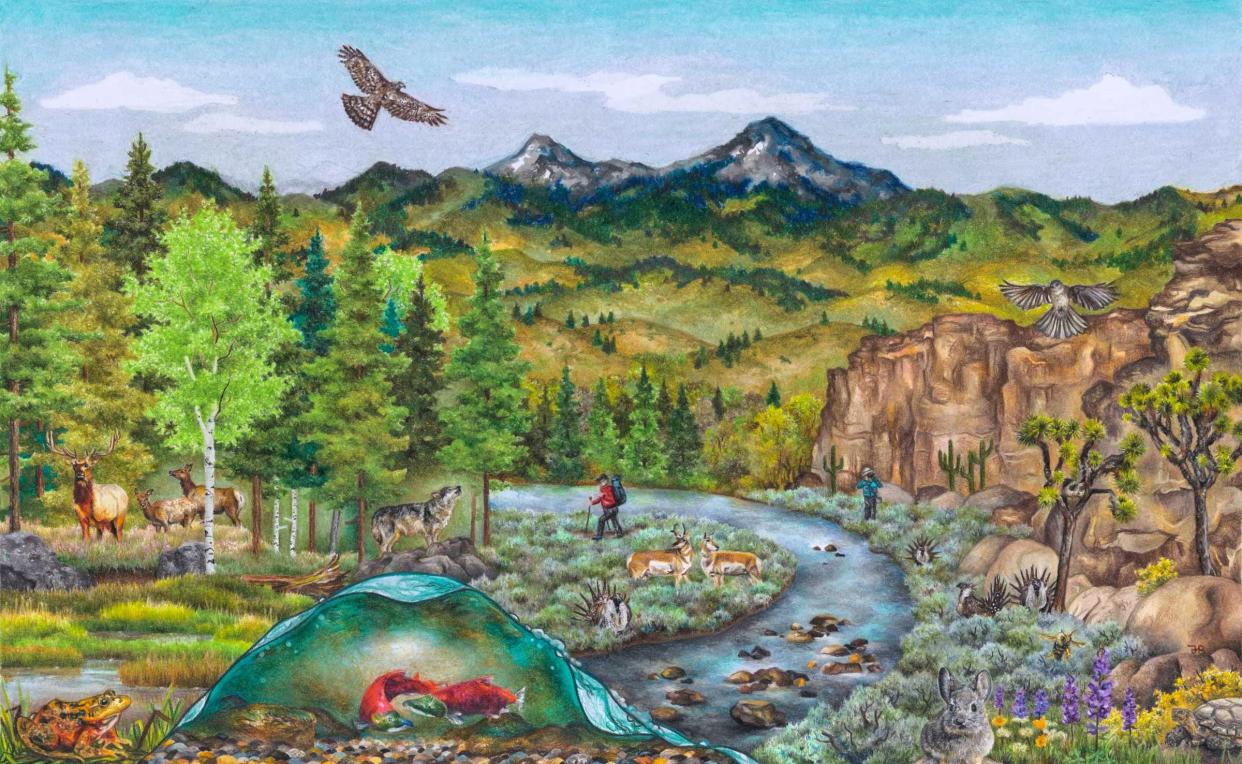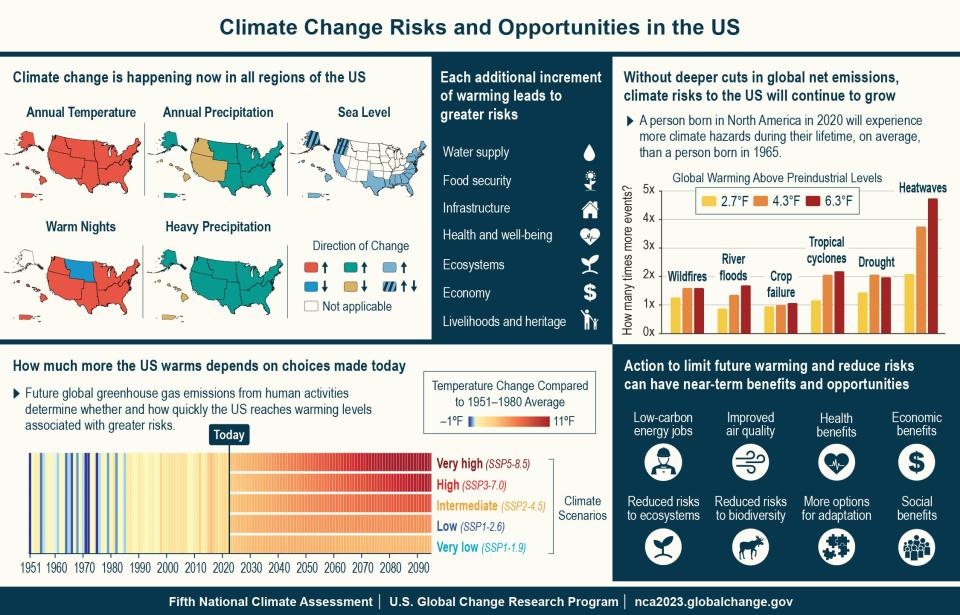'We can't be complacent:' Climate report offers mix of familiar warnings, new solutions

President Joe Biden introduced on Tuesday the Fifth National Climate Assessment report, a comprehensive update to the fourth version published in 2018 and the result of four years of work by more than 750 experts, with input from thousands of American contributors. It draws from published research, observed impacts and projected vulnerabilities to assemble a guide to risks, opportunities and actions related to climate change in the United States.
In his announcement, Biden used one phrase repeatedly:
"We can't be complacent."
Overall, the assessment reports a mix of distressing and encouraging findings, some familiar, some new.
The best news might be that annual U.S. greenhouse gas emissions, which are released when humans burn fossil fuels for energy and are responsible for trapping extra heat in the atmosphere, dropped 12% between 2005 and 2019. This is in part because a shift toward renewable energy sources enabled a 40% drop in emissions from the electricity sector. The progress doesn't appear to have come at a cost to domestic growth, since both the U.S. population and per capita GDP increased over that time.
Nonetheless, the report underscores that average temperatures have gone up nationwide since the last assessment, causing unexpected shifts that have been difficult to manage for some industries and communities. The fifth assessment made particular strides in seeking to be more inclusive and address how consequences of warmer temperatures and intensified storms fall heaviest on already vulnerable and disadvantaged people.
One reflection of this is the fact that this national climate assessment will be the first of the series to be translated into Spanish, though that version is not yet available.
Zooming in, the report anticipates worsened climate impacts in all 10 regions of the country, while also highlighting examples of novel climate action in those places. Sea level rise is jeopardizing resources like roadways and fresh water in all coastal regions. Heavy precipitation is a threat across the entire mainland, at the same time that persistent drought plagues the West and Hawaii and increases the risk of large wildfires. Warmer overnight temperatures are an issue everywhere but the Northern Great Plains.
All of these factors deal blows to human health, food security and ecosystem stability.

But proactive relief has also come in the form of new storm water codes in the northeast reducing the risk of catastrophic flooding; wetland and forest restoration projects designed to stabilize critical habitats and sequester carbon in the Midwest; substantial wind energy expansions in the Southern Great Plaines; and kelp farming to reduce ocean acidification off the coast of Alaska.
Continued progress toward net-zero targets, which are critical to protect access to livable air quality, fresh water, productive agriculture and more, will require aggressive action to expand similar programs and to adjust societal choices and attitudes about fossil fuel use, the report concludes.

Action has come too slow, experts say, but a shift can still help
Even with updates about new climate action across the nation, many of the report's points strike a familiar chord.
For more than 50 years, scientists have warned the public about the impacts of a warming climate. Research documenting the role of carbon dioxide, the most common greenhouse gas, dates back at least 100 years before that.
Eunice Foote, 1850s climate scientist: The power of the sun, of the people and of politics. The climate depends on all 3
But so far, climate experts agree that action to correct this imbalance has been much too slow.
The U.S. had one of many chances to change course in 1988, when scientist James Hansen testified before Congress about the reality of global warming. At the time, the need to control it was accepted, embraced even, by Republican Presidents Ronald Reagan and George W. Bush. In 1990, Bush signed into law the Global Change Research Act, proposed by the Reagan administration, mandating that a national climate assessment be produced about every four years.
But misinformation campaigns sponsored by fossil fuel companies have since sown widespread doubt about climate change, despite their own inside knowledge that ongoing use of its product would complicate life on Earth for humans, effectively stalling political progress for the next two generations.
In the last few years, climate change has become nearly impossible to deny. "Natural" disasters gone off the rails, intensified by the extra heat energy in the atmosphere, cost the U.S. $178 billion in damages last year and left no corner of the country untouched. Even scientists are now expressing dismay at how quickly impacts are accelerating, alarmed by how rapidly their own warnings are coming true.
Your carbon footprint liability: Climate change is not your fault, but that doesn't mean you're off the hook
By all educated measures, action to control the climate crisis has been — as Biden warns against —complacent.
But this president has seen its acceleration while in office like no other. It's part of why his administration worked to pass historic climate legislation with last year's Inflation Reduction Act, which has already funded dozens of domestic climate mitigation initiatives.
On Tuesday, Biden mentioned visiting locations in the east where historic hurricanes have wiped homes, hospitals and places of worship "right off the map." He recalled seeing sites in the middle of the country where extreme winter storms and tornados left devastation in their wake. He spoke about megafires that have torched communities as far west as Hawaii during his administration, and noted the far-reaching effects of smoke pollution that lingers long afterward. He lamented the loss of huge swaths of forests that help structure landscapes, provide wildlife habitat and timber resources and store heat-trapping carbon.
And he mentioned Arizona, where heat and heat-associated deaths hit all-time-highs this year.
"Record temperatures in Texas, Arizona and elsewhere are affecting the lives and livelihoods of more than one hundred million Americans," Biden said. "This summer and this fall have been the Earth's hottest since the global records began to be kept in the 1800s. Think about that. The hottest we've ever recorded in history. It's an impact decades in the making because there was inaction for much too long."
Our investigation into heat and housing: As Arizona builds to solve a housing crisis, will its homes withstand future heat extremes?
Warnings for the Southwest: Water, coasts, agriculture, human health and wildfire
The report's 28th chapter identified five key areas of climate concern for the Southwest region, which includes Arizona, California, Colorado, Nevada, New Mexico and Utah.
Dave White, a professor at Arizona State University and director of its Global Institute of Sustainability and Innovation, served as lead author on the Southwest chapter. He talked to The Arizona Republic about what to expect from climate change and climate action in Arizona.
"First, we conclude that the drought and increasing aridity are threatening water resources in the region," White said. "There is new science that illustrates how higher temperatures are really driving much of the change and intensifying drought."
The second key message about sea level rise, coastal flooding and saltwater intrusion is most salient for California, which White says is setting a good example for the region of how to apply climate science to mitigation plans.

Third, authors of the Southwest chapter document how climate challenges are increasingly creating obstacles for regional food and fiber production.
"Extreme heat is increasing animal stress and reducing crop quality yield," White said. "We also note how people in this region have adapted to drought impacts for millennia, and identify some promising strategies where incorporating Indigenous knowledge along with technology can offer some solutions for food security in the region."
The fourth key message centers on human health and demographics, a newer and increasingly important topic as more climate research discovers unexpected health impacts, particularly among already at-risk groups.
Arizonans are well versed in the far-ranging physiological impacts of extreme heat. A record-breaking extreme heat wave that lasted almost all of July in Phoenix exacted a local heat death toll far beyond that of previous years.
Recent research to reduce heat deaths: In a heat wave, some people wait too long to turn on the AC. Smart data use could help
The final section describes how, in recent years, the Southwest has experienced unprecedented wildfire events that are driven in part by climate change, White said, and how their size and severity is projected to worsen over time.
“The climate impacts are rapidly accelerating, even in the last five years since the 2018 report," White said. "Throughout the chapter, we present the connections between all of these different issues and identify ways in which science has progressed in our understanding of how water, food, agriculture, fire and human health are interconnected, which helps to inform adaptations.
"There is an emphasis in this report on our improved understanding of how climate change is being felt by Americans, and it’s being felt as extreme events."
Dawn of a new climate action era?
When the Fourth National Climate Assessment report came out in 2018, the Trump administration tried to bury it. Trump said he "didn't believe" the conclusion of American scientists that global warming is causing widespread damage and economic losses.
Activists believe this stance cost the nation valuable time in avoiding the worst impacts and led directly to increased suffering and inequities now and in the future.
In his announcement of the updated report Tuesday, Biden highlighted the difference between his and the previous administration's stance on the urgency of climate change.
"We're sharing this report in detail with the American people so they know exactly what they're facing and what we're going to have to do," Biden said. "Anyone who willfully denies the impact of climate change is condemning the American people to a very dangerous future."
Whether Americans can get back on track with the burgeoning climate awareness of the 1980s and avoid the climate denial pitfalls of subsequent decades to chart a straighter path toward climate mitigation will be decided now, experts agree. The overall consensus Tuesday surrounding the new report was one of hope for the future and excitement about the better-informed actions and investments that lie ahead.
"Thank you for noticing, for paying attention, even when it seems like people aren't listening," said Ada Limón, the United States' 24th poet laureate, when introducing one of her poems during a briefing about the report. "Thank you for the deep looking that is required. I really believe that the Fifth Climate Assessment is a true act of service. Don't make it about the past. Don't make it nostalgic. Make it about moving forward. Make it about where you are."
Read our climate series: The latest from Joan Meiners at azcentral, a column on climate change that publishes weekly
As a year of record-setting heat and climate impacts winds down, Biden expressed optimism for the country's future — if Americans take advantage of his administration's more than $370 billion in climate-mitigating program offerings.
"Above all," Biden said, the report "shows us that climate action offers an opportunity for the nation to come together and do some really big things."
Joan Meiners is the climate news and storytelling reporter at The Arizona Republic and azcentral.com. Before becoming a journalist, she completed a doctorate in ecology. Follow Joan on Twitter at @beecycles or email her at joan.meiners@arizonarepublic.com. Read more of her coverage at environment.azcentral.com.
Sign up for AZ Climate, The Republic's weekly climate and environment newsletter.
Support climate coverage and local journalism by subscribing to azcentral.com at this link.
This article originally appeared on Arizona Republic: Biden introduces new climate report, a mix of warnings and solutions

